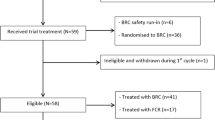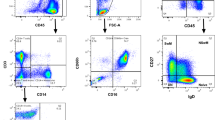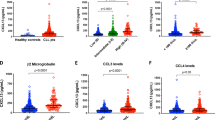Abstract
The long median survival time of patients with follicular non-Hodgkin's lymphoma (NHL), means that the efficacy of new treatments are difficult to assess in the short term. Bcl-2 is an inhibitor of apoptosis and overexpression of the bcl-2 gene in the blood or bone marrow is a feature in up to 85% of patients with follicular NHL. Levels of bcl-2+ cells in the peripheral blood or bone marrow therefore are a useful measure of disease status in such patients and can be detected by polymerase chain reaction (PCR). Complete bcl-2 clearance from the bone marrow (molecular remission) following autologous stem cell transplant (ASCT) for follicular NHL is considered to be an important prognostic factor for disease-free survival. Tumour cell contamination of the stem cell grafts used in ASCT is commonly associated with relapse. This can be addressed by purging the stem cell harvest prior to transplantation. Various methods of in vitro purging after stem cell collection have been shown to reduce the level of contamination but yield is invariably reduced and grafts remain bcl-2 positive. However, in vivo purging with rituximab during the process of collection has been used to obtain bcl-2-negative stem cell harvests without compromising the yield. Rituximab is a monoclonal antibody licensed for treatment of relapsed and refractory low-grade or follicular NHL. Rituximab targets the CD20 antigen, which is found on cells of the B cell lineage. When used for in vivo purging it depletes the peripheral blood of CD20-positive cells and prevents contamination by lymphoma cells. Molecular remission, as measured by bone-marrow bcl-2 clearance, has been achieved in 7/7 patients with follicular NHL at 1 year after treatment with ASCT using rituximab as an ‘in vivopurse’, followed by rituximab maintenance. Early clinical outcomes are also encouraging.
Bone Marrow Transplantation (2002) 29, Suppl. 1, S14–S17. doi:10.1038/sj.bmt.1703297
This is a preview of subscription content, access via your institution
Access options
Subscribe to this journal
Receive 12 print issues and online access
$259.00 per year
only $21.58 per issue
Buy this article
- Purchase on Springer Link
- Instant access to full article PDF
Prices may be subject to local taxes which are calculated during checkout


Similar content being viewed by others
References
Horning SJ, Rosenberg SA . The natural history of initially untreated low-grade non-Hodgkin's lymphomas New Engl J Med 1984 311: 1471 1475
Baldini L, Guffanti A, Gobbi P et al. A pilot study on the use of the ProMACE-CytaBOM regimen as a first-line treatment of advanced follicular non-Hodgkin's lymphoma. Gruppo Italiano per lo Studio dei Linfomi Cancer 1997 79: 1234 1240
Hagenbeek A, Eghbali H, Monfardini S et al. Fludarabine versus conventional CVP chemotherapy in newly diagnosed patients with stages III and IV low grade non-Hodgkin's lymphoma. Preliminary results from a prospective randomized phase III clinical trial in 381 patients Blood 1998 92: 315a
Gribben JG, Freedman AS, Woo SD et al. All advanced stage non-Hodgkin's lymphomas with a polymerase chain reaction amplifiable breakpoint of bcl-2 have residual cells containing the bcl-2 rearrangement at evaluation and after treatment Blood 1991 78: 3275 3280
Berinstein NL, Reis MD, Ngan BY et al. Detection of occult lymphoma in the peripheral blood and bone marrow of patients with untreated early-stage and advanced-stage follicular lymphoma J Clin Oncol 1993 11: 1344 1352
Liu Y, Hernandez AM, Shibata D et al. BCL2 translocation frequency rises with age in humans Proc Natl Acad Sci USA 1994 91: 8910 8914
Chao DT, Korsmeyer SJ . BCL-2 family: regulators of cell death Annu Rev Immunol 1998 16: 395 419
Freedman AS, Neuberg D, Mauch P et al. Long-term follow-up of autologous bone marrow transplantation in patients with relapsed follicular lymphoma Blood 1999 94: 3325 3333
Lopez-Guillermo A, Cabanillas F, McLaughlin P et al. The clinical significance of molecular response in indolent follicular lymphomas Blood 1998 91: 2955 2960
Lopez-Guillermo A, Cabanillas F, McLaughlin P et al. Molecular response assessed by PCR is the most important factor predicting failure-free survival in indolent follicular lymphoma: update of the MDACC series Ann Oncol 2000 11 (Suppl. 1): 137 140
McLaughlin P, Grillo-Lopez AJ, Link BK et al. Rituximab chimeric anti-CD20 monoclonal antibody therapy for relapsed indolent lymphoma: half of patients respond to a four-dose treatment program J Clin Oncol 1998 16: 2825 2833
Czuczman MS, Grillo-Lopez AJ, McLaughlin P et al. Clearing of cells bearing the bcl-2 [t(14;18)] translocation from blood and marrow of patients treated with rituximab alone or in combination with CHOP chemotherapy Ann Oncol 2001 12: 109 114
Gribben JG, Neuberg D, Barber M et al. Detection of residual lymphoma cells by polymerase chain reaction in peripheral blood is significantly less predictive for relapse than detection in bone marrow Blood 1994 83: 3800 3807
Gribben JG, Neuberg D, Freedman AS et al. Detection by polymerase chain reaction of residual cells with the bcl-2 translocation is associated with increased risk of relapse after autologous bone marrow transplantation for B-cell lymphoma Blood 1993 81: 3449 3457
Paulus U, Dreger P, Viehmann K et al. Purging peripheral blood progenitor cell grafts from lymphoma cells: quantitative comparison of immunomagnetic CD34+ selection systems Stem Cells 1997 15: 297 304
Fouillard L, Laporte JP, Labopin M et al. Autologous stem-cell transplantation for non-Hodgkin's lymphomas: the role of graft purging and radiotherapy posttransplantation – results of a retrospective analysis on 120 patients autografted in a single institution J Clin Oncol 1998 16: 2803 2816
Horning JS . Investigation of monoclonal antibody therapy with conventional and high-dose treatment: current clinical trials Semin Hematol 2000 37 (4 Suppl. 7): 27 33
Anderson KC, Bates MP, Slaughenhoupt BL et al. Expression of human B cell-associated antigens on leukemias and lymphomas: a model of human B cell differentiation Blood 1984 63: 1424 1433
Reff ME, Carner K, Chambers KS et al. Depletion of B cells in vivo by a chimeric mouse human monoclonal antibody to CD20 Blood 1994 83: 435 445
Shan D, Ledbetter JA, Press OW . Apoptosis of malignant human B cells by ligation of CD20 with monoclonal antibodies Blood 1998 91: 1644 1652
Coiffier B, Lepage E, Herbrecht R et al. MabThera (rituximab) plus CHOP is superior to chop alone in elderly patients with diffuse large B-cell lymphoma (DLCL): interim results of a randomized GELA trial Blood 2000 96: 950a
Czuczman MS, Grillo-Lopez AJ, White CA et al. Treatment of patients with low-grade B-cell lymphoma with the combination of chimeric anti-CD20 monoclonal antibody and CHOP chemotherapy J Clin Oncol 1999 17: 268 276
Maloney DG, Liles TM, Czerwinski DK et al. Phase I clinical trial using escalating single-dose infusion of chimeric anti-CD20 monoclonal antibody (IDEC-C2B8) in patients with recurrent B-cell lymphoma Blood 1994 84: 2457 2466
Buckstein R, Imrie K, Spaner D et al. Stem cell function and engraftment is not affected by ‘in vivo purging’ with rituximab for autologous stem cell treatment for patients with low-grade non-Hodgkin's lymphoma Semin Oncol 1999 5 (Suppl. 14): 115 122
Salles G, Moullet I, Charlot C et al. In vivo purging with rituximab before autologous peripheral blood progenitor cell (PBPC) transplantation in lymphoma patients (pts) Blood 1999 94 (Suppl. 1): 141a
Haioun C, Delfau-Larue MH, Beaujean F et al. Efficiency of in vivo purging with rituximab followed by high-dose therapy (HDT) with autologous peripheral blood stem cell transplantation (PBSCT) in B-cell non-Hodgkin's lymphomas (NHL). A single institution study Blood 2000 96: 384a
Author information
Authors and Affiliations
Corresponding author
Rights and permissions
About this article
Cite this article
Berinstein, N., Buckstein, R., Imrie, K. et al. Bcl-2 clearance: optimising outcomes in follicular non-Hodgkin's lymphoma. Bone Marrow Transplant 29 (Suppl 1), S14–S17 (2002). https://doi.org/10.1038/sj.bmt.1703297
Published:
Issue Date:
DOI: https://doi.org/10.1038/sj.bmt.1703297
Keywords
This article is cited by
-
The role of rituximab in autologous and allogeneic hematopoietic stem cell transplantation for non-Hodgkin’s lymphoma
Current Hematologic Malignancy Reports (2006)
-
Ex vivo B cell depletion using the Eligix B Cell SC system and autologous peripheral blood stem cell transplantation in patients with follicular non-Hodgkin's lymphoma
Bone Marrow Transplantation (2003)
-
Anti-CD20-based therapy of B cell lymphoma: state of the art
Leukemia (2002)



